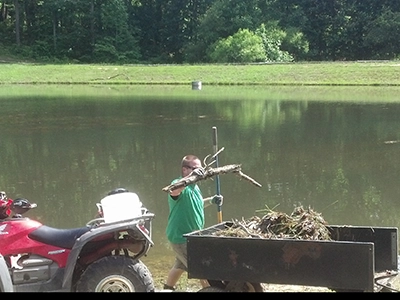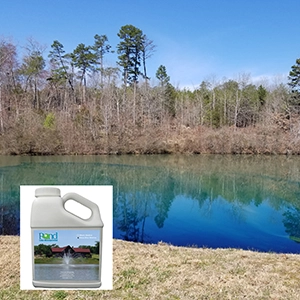Tools needed for a Pond Clean Up
Pond Clean Up requires tools to cut and rake up weeds, and break up muck
Your pond is a mess! It’s filled with pond weeds and other organic material such as fallen trees, grass clippings and leaves from nearby trees and bushes. It is time for a pond clean up! The next step? Decide wether you will hire a pond maintenance expert like Pond Lake Management, or conduct the pond clean up yourself.
Table of Contents: What you will find in this post
• Introduction
• Pond Clean Up: Do it yourself or hire a professional?
• Remove dead tree branches, limbs and brush
• Clean up dead leaves, grass clippings and other organic material
• Remove Pond Weeds
• Add Pond Dyes or other chemicals for long term Pond cleanliness
• Conclusion
• Frequently Asked Questions
Pond Clean Up: Do it yourself or hire a professional?
First, you need to make a decision. Are you going to clean up the pond yourself or do you want to hire a pond maintenance professional? Pond management experts like Pond Lake Management have the expertise, tools and personnel for stormwater retention pond clean up, farm ponds, or other large ponds.
In addition to experience, if you have a stormwater retention pond that is regulated by your local government, Pond Lake Management can help with stormwater notices, pond repairs and more.
Remove dead tree branches, limbs and brush
First things first. Remove any tree limbs, brush and other organic material by hand.
Larger objects may require help from a tractor and chains. Always remember safety first! We suggest working with a partner and pay close attention to risky situations. Keep tools requiring electricity away from water, and never use an electric tool while you are in the water.
Clean up dead leaves, grass clippings and other organic material
Remove dead leaves and other organic material and dispose of it away from your pond. You want to keep leaves, grass clippings and compost from blowing into your pond, decomposing and turning into nitrogen which feeds algae and pond weeds.
Pro tip: if you mow close to the waters edge, point your mowers exit chute away from the pond, to help minimize grass clippings in the water.
1. Cut the Pond Weeds with a tool like the Pond Razor
With a good pond razor weed cutter to cut off pond weeds in the pond, Pond Lake Management uses the Weed Razor Pro to help trim weed growth. With blade lengths of 48 or
62 inches, a 5 foot handle and a 25 foot rope.
The best way to use a weed cutter is to adjust the blades from their full 62″ to shorter lengths
for heavy weed growth. We suggest laying out a pattern and cut the weeds in a disciplined
manner. Once the pond weeds have been cut you can proceed to removing the pond weeds
with a weed rake.
2. Remove pond weeds with a Pond Weed Rake
Once you have cut the weeds you will need to remove the weeds before they decompose with a pond weed rake into muck and start making your pond unhealthy, and unappealing
Use our 37″ wide rake head, long 8″ teeth, and sturdy aluminum handle, the Weed Raker can easily remove the tangled roots of aquatic vegetation. Removing vegetation before it decomposes will greatly reduce pond muck. Includes 11′ handle and 43′ rope.
3. Reduce Pond Muck and dig out Vegetation by the roots
Use a muck raker tool to help muck decompose and dig out existing weeds by the roots. Designed with hooked teeth made of galvanized steel, the Muck Razer will give you a clean, weed-free swimming and beach areas.
Easy to use, simply place the drum into the water and push back and forth across any muck or submerged aquatic vegetation. This agitation aerates the muck layer allowing natural bacteria such as MuckAway. to accelerate muck decomposition helping to produce a firm pond bottom.
The Pond Muck Raker includes a 12′ three-piece handle, 24″ x 6″ diameter. drum and heavy-duty galvanized steel teeth.
Pond Dyes limit sunlight from entering the pond depths to help minimize future weed growth. The appropriate pond chemicals will reduce specific pond weeds from growing back. We recommend that you always consult with a professional before using pond chemicals. The proper chemical, applied in the correct proportions, can make the difference in your ponds health. Used incorrectly, chemicals can harm good vegetation, and other aquatic life. Consult a pond management professional, read directions, and test your applications.
These solar powered geese deterrent lights complement your solar powered aerators, they shine light at the Geese’s eye level. The Away with Geese, geese deterrent lights have a 360 degree pulse of light with a 100-yard reach.
Conclusion:
A clean pond is a healthy pond! Keep unwanted pond weeds and algae in control by manually cleaning out your pond. The fewer weeds in your pond, the less pond muck and decomposed organic matter you will need to worry about cleaning out in the future.
Consistent pond clean up takes time, if you don’t have the time to look after your pond, consider securing a pond maintenance plan. Pond Lake Management will take care of all of your pond’s needs, from weed control to adding Geese Deterrent lights and installing pond Aeration and Fountains.
Pond Lake Maintenance your Pond Management Experts in North Carolina
We clean up ponds and provide pond management services including algae and weed control to achieve the proper mix of beneficial aquatic plants to keep your pond or lake healthy. We also do bathymetric mapping and lake monitoring.
We are a leading Pond Management Company, we install aerators, fountains, and diffuser systems from AirMax, Outdoor Water Solutions and Kasco to keep your ponds healthy and visually appealing.
What are the essential hand tools for cleaning out pond weeds and muck?
For a successful pond cleanup, a few key hand tools will make the job much easier. A long-handled pond or landscape rake is your most versatile tool. It’s perfect for pulling out floating weeds, loose algae, and sunken leaves from the bottom. For cutting through tougher, rooted aquatic plants, consider an aquatic weed cutter or a serrated lake weed rake. To deal with accumulated muck and sludge, a simple shovel or spade can help you scoop out the decomposed material, especially around the edges of your pond.
How can I remove weeds and algae that are floating on the pond's surface?
Floating weeds and algae are best managed with tools designed for skimming and pulling. A pond skimmer net, which looks like a large pool skimmer, is excellent for collecting smaller floating debris and algae mats.
For larger patches of floating weeds or material that is slightly submerged, a long-handled pond rake is very effective. You can cast it out and drag it back to shore, pulling the unwanted vegetation with it. These simple tools allow you to clear the surface quickly without needing to get into the water.
I have tough, rooted weeds on the bottom of my pond. What tools can cut them?
Dealing with rooted aquatic weeds requires tools with cutting power. An aquatic weed cutter, often called a “V-cutter” or “weed razor,” is a great option. These are typically weighted, V-shaped blades attached to a rope that you can toss into the weedy area and pull back, slicing through the stems at their base.
Another effective tool is a serrated weed rake. Unlike a standard rake, its sharp teeth can saw through tougher vegetation as you drag it across the pond bottom, uprooting and cutting the plants for easy removal
What tool is best for removing the soft muck and sludge at the bottom of my pond?
To remove soft muck and sludge, a tool called a “muck scoop” or “muck raker” is highly effective. It works much like a giant dustpan for your pond. You can push it along the pond floor to break up the decomposing leaves, sediment, and other organic gunk. For areas closer to the shore, a sturdy shovel or a wide landscape rake can also be used to pull the sludge out of the water.
Are there any tools that can help me reach weeds and debris far from the shore?
Yes, for reaching distant weeds and debris, throwable tools are your best bet. A “weed razor” or aquatic weed cutter is designed to be tossed out into the pond and retrieved with an attached rope, cutting a wide path of vegetation as it’s pulled in.
Similarly, some pond rakes are designed with long ropes. You can throw the rake head out into the middle of the pond and drag it back to shore, collecting floating algae, submerged weeds, and other debris that’s beyond the reach of a long-handled tool.
What safety gear should I wear while cleaning my pond?
Even for a simple cleanup, safety is important. A good pair of waterproof gloves, like heavy-duty rubber or nitrile-coated ones, will protect your hands from sharp objects and muck. It’s also wise to wear waterproof boots or waders to keep your feet dry and provide good traction on slippery banks. Finally, consider safety glasses to protect your eyes from accidental splashes, especially when you are slinging tools or pulling out weedy debris.







